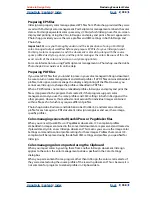
Using Help
|
Contents
|
Index
Back
347
Adobe InDesign Help
Producing Consistent Color
Using Help
|
Contents
|
Index
Back
347
Specifying a rendering intent
Translating colors to a different color space usually involves adjusting the colors to accom-
modate the gamut of the destination color space. Different translation methods use
different rules to determine how the source colors are adjusted; for example, colors that
fall inside the destination gamut may remain unchanged, or they may be adjusted to
preserve the original range of visual relationships as translated to a smaller destination
gamut. These translation methods are known as
rendering intents
,
because each technique
is optimized for a different intended use of color graphics.
Note:
The result of choosing a rendering intent depends on the graphical content of
documents, and on the profiles used to specify color spaces. Some profiles produce
identical results for different rendering intents. Differences between rendering intents are
apparent when you print a document or convert it to a different working space. Differ-
ences may also be visible when soft- or hard-proofing.
The following rendering intent options are available:
Perceptual
This intent aims to preserve the visual relationships between colors in a way
that is perceived as natural by the human eye, although the color values themselves may
change.
Saturation
Appropriate for office and presentation graphics, this intent aims to create
vivid color at the expense of accurate color. It scales the source gamut to the destination
gamut but preserves relative saturation instead of hue, so that when translating to a
smaller gamut, hues may shift. This rendering intent is suitable for business graphics,
where the exact relationship between colors is not as important as having vivid colors.
Absolute Colorimetric
Leaves colors that fall inside the destination gamut unchanged.
This intent aims to maintain color accuracy at the expense of preserving relationships
between colors. When translating to a smaller gamut, two colors that are distinct in the
source space may be mapped to the same color in the destination space.
Relative Colorimetric
This intent is identical to absolute colorimetric, except for the
following difference: relative colorimetric compares the
white point
(extreme highlight) of
the source color space to that of the destination color space, and shifts all colors accord-
ingly. The relative colorimetric intent can be more accurate if the image’s profile contains
correct white point information. This is the default rendering intent used by all predefined
color management configurations.
Using black-point compensation
The Use Black Point Compensation option controls whether to adjust for differences in
black points when converting colors between color spaces. When this option is enabled,
the full dynamic range of the source space is mapped into the full dynamic range of the
destination space. When this option is disabled, the dynamic range of the source space is
simulated in the destination space; although this mode can result in blocked or gray
shadows, it can be useful when the black point of the source space is lower than that of
the destination space.
The Use Black Point Compensation option is selected for all predefined color management
configurations. Keeping this option selected is highly recommended.






























